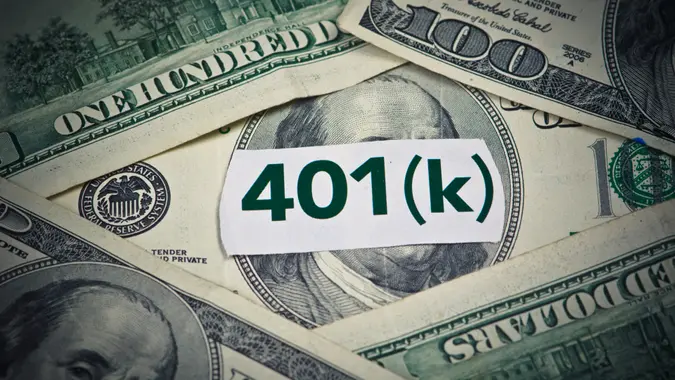7 Most Valuable Ways to Save for Retirement

Commitment to Our Readers
GOBankingRates' editorial team is committed to bringing you unbiased reviews and information. We use data-driven methodologies to evaluate financial products and services - our reviews and ratings are not influenced by advertisers. You can read more about our editorial guidelines and our products and services review methodology.

20 Years
Helping You Live Richer

Reviewed
by Experts

Trusted by
Millions of Readers
One of the best ways to save for retirement is to take advantage of a workplace retirement plan, such as a 401k. Typically, contributions can be automatically withdrawn from your paycheck so the money goes into savings before you even have a chance to spend it. Plus, the money comes out of your paycheck pretax, so it lowers your taxable income — which means a lower tax bill. And if your employer matches your contribution, that’s like getting free money.
However, if you don’t have access to a workplace retirement plan, will contribute the maximum 401k limit of $18,000 in 2016 or want a variety of sources of retirement income, there are other valuable ways to save. Here are seven to consider.
1. SEP-IRA or Solo 401k
If you’re self-employed, you can save for retirement with a SEP-IRA or Solo 401k account. “It’s a great way for people who don’t have a 401k at work to create one for themselves,” said Brad Sherman, a financial planner and founder of Sherman Wealth Management.
These accounts can be more valuable than a traditional IRA because the contribution limits are higher, Sherman said. With a SEP-IRA, you can contribute 20 percent of net income, up to a maximum of $53,000. A Solo 401k lets you act as both an employee and employer. You can contribute up to $18,000 as an employee plus 20 percent of business earnings, up to a maximum of $53,000. Contributions to both plans are tax-deductible.
Read: How Much Money Do I Need to Retire?
2. Roth IRA
Regardless of whether you have access to a retirement plan at work, a Roth IRA can be a great part of your retirement savings strategy. “The Roth IRA works as a diversification tool,” Sherman said. “It’s a bucket of money growing tax-deferred and also comes out tax-free.”
You can contribute the maximum of $5,500 — $6,500 if you’re 50 or older — if you’re single and your modified adjusted gross income is less than $116,000, or if you’re a married couple filing jointly with a modified adjusted gross income of less than $183,000. IRS rules limit the amount you can contribute if you’re single and make between $116,000 and $131,000, or between $183,000 and $193,000 if you’re married and filing jointly. You’re cut off completely from making contributions if your income exceeds the higher end of those limits.
You can’t deduct contributions to a Roth IRA. However, you don’t have to pay taxes when you withdraw money from a Roth, as long as you’re 59½ or older and have had the account for at least five years. Withdrawals from a traditional IRA and 401k, on the other hand, are taxed at your regular income tax rate, which means the Roth can give you more spendable money in retirement.
A study by T. Rowe Price found that an investor who starts saving at age 25 and stays in the same tax bracket in retirement would have nearly 20 percent more spendable income with a Roth than a traditional IRA because withdrawals are tax-free. Even investors who don’t start saving at a young age or whose tax rates will drop in retirement can still benefit more from a Roth, according to the study.
If your income is too high to contribute to a Roth IRA, there is a backdoor way into this account, said George Clough, a certified financial planner and vice president of wealth management strategies at People’s United Bank. You can open and fund a traditional IRA, then convert it to a Roth IRA, he said. You will have to pay taxes on the amount you convert, but withdrawals will be tax-free in retirement.
3. Health Savings Account
A health savings account (HSA) is meant to be a way to allow people with high-deductible health insurance policies to set aside money for out-of-pocket medical costs. It can also be a creative way to create a pool of income for retirement, said Clough. The best part is that you can tap this pool of income, tax-free, if you use the money to pay for qualified medical expenses.
In 2016, you can contribute up to $3,350 if you have an individual health insurance policy with a deductible of at least $1,300. If you have family coverage with a deductible of at least $2,600, you can contribute up to $6,750. Contributions are tax-deductible or made with pre-tax dollars.
Your contributions can roll over from one year to the next if you don’t use them, and continue to grow tax-deferred. The extra funds can be applied toward retirement savings, as the account essentially acts like an individual retirement account, said Steve Christenson, executive vice president at Ascensus, an independent retirement and college savings services provider. “This ability for long-term savings can be more beneficial to Generation X and millennials as they have a longer period to save and invest in conjunction with other qualified retirement plans,” he said.
Rather than tap other retirement accounts and pay taxes on those withdrawals, you can use HSA funds to cover medical expenses in retirement — which Fidelity Investments estimated will be $245,000 for a couple retiring at age 65. If you use HSA funds for other reasons, withdrawals are taxed at your regular income tax rate, Christenson said.
Discover: 10 Low-Paying Jobs That Will Actually Pay Off in Retirement
4. Cash Value Life Insurance
If you’ve maxed out the retirement savings accounts that are available to you, you might want to consider adding a cash-value life insurance policy to your savings strategy. “Life insurance can be a great planning tool if used and funded properly,” said Scott Bishop, director of financial planning at STA Wealth. “It’s a great bucket to manage taxes in retirement.”
A cash value life insurance policy pays a death benefit, but it also builds up value that a policyholder can borrow from, tax-free, if you take the money out as structured policy loans, Bishop said. The cash value will grow at a guaranteed rate or variable rate, depending on the type of policy you choose. You could get a 4 percent to 6 percent tax-free rate of return, he said. “It’s not like you’re going to be hitting home runs on it … but you won’t strike out on it,” he added.
The key is to buy a policy from a highly-rated insurance company that pays good dividends, or has a good performance history and doesn’t charge a penalty for taking out policy loans. The strategy works best for younger adults who are in good health (to get better rates) and have 15 years or more to pay premiums and build up cash value before tapping the policy, Bishop said.
Another way to use cash value life insurance as part of your retirement-planning strategy is to get a hybrid policy that includes long-term benefits, Clough said. This will allow you to tap the policy for long-term care — which can be incredibly expensive — if you need it.
If you don’t use the long-term-care benefit, you won’t have wasted money on premiums because the life insurance benefit will still be in effect, or the cash value could be tapped for other retirement expenses. “It translates into flexibility,” said Clough.
5. Taxable Investment Account
If you want to invest outside a tax-deferred retirement account, you can invest directly in stocks, bonds, mutual funds and other securities with a brokerage account. You won’t get a deduction for contributing to a taxable account, nor can you use pre-tax dollars to invest (as you would with a 401k).
However, saving in a taxable investment account could help minimize taxes in retirement. When it comes to saving for retirement, it’s not just about how much you have, but “how much you have after you pay taxes,” said Clough.
Investment earnings are treated as capital gains. If you hold an asset for more than a year before selling it, your earnings are treated as long-term capital gains and taxed at 0 percent to 15 percent, depending on your income tax bracket. Withdrawals from retirement savings accounts such as a 401k or traditional IRA are treated as ordinary income and taxed at a rate of up to 39.6 percent.
6. Annuities
If you have a low tolerance for risk and want a guaranteed stream of income in retirement, an annuity might be a valuable retirement savings vehicle for you. You can invest a lump sum into this insurance product, then get a regular fixed payment over several years or the rest of your life. The rate of return is relatively low but better than what other fixed-income assets, such as certificates of deposit, pay, Bishop said.
For example, if you invest $50,000 in a Fidelity deferred income annuity and start payouts at age 65, you’ll get $375 per month for the rest of your life. Payouts are taxed as regular income.
With annuities, it’s important to pay attention to fees and commissions and how long you must wait before annuitizing. Don’t just listen to the sales pitch you might get, Bishop said. Make sure you understand what you’re buying.
Related: 12 Investing Hacks for Beginners
7. Real Estate
Another way to create income in retirement is by investing in rental properties. “For retirement, income properties are great, especially if you can pay off the mortgage by the time you retire,” Bishop said. It can be a risky retirement savings strategy, though, because there can be periods when you don’t have renters, maintenance bills can be high or you buy properties that don’t pay off.
To do well, you have to treat real estate investing like a business and have a plan, Bishop said. The return also needs to be high enough to make it worth the trouble of managing properties — or the cost of hiring someone to do it for you. “If you only get a 4 percent return, don’t give yourself that headache,” he said. “Aim for 8 percent or higher.”
Bishop said you should consider hiring a real estate broker to pinpoint properties that are likely to yield a higher return and consulting with a CPA or other tax professional to maximize the tax advantages of owning rental property.
 Written by
Written by  Edited by
Edited by 
































